#Odysseus would not have given his name after being warned otherwise if he had not been in the beginnings of grief
Explore tagged Tumblr posts
Text

Right back at you on the tags because I could talk about this for so long
thinking about epic the musical. thinking about polites. thinking about how they decided to kill polites at the cyclops, and not have him be a part of convincing odysseus to leave circe. thinking about how early they took out odysseus's conscience personified. and also how odysseus doesn't kill polyphemus despite him killing odysseus's best friend.
#epic the musical#IT ALL CIRCLES BACK TO HIM TRYING TO BECOME POLITES VERSION OF MERCY#if he had accepted what Polites said and incorporated it into his present ideals then the whole journey would Not Have Happened Like That#he wouldn’t have had to later adapt to Poseidon’s version of mercy being ruthlessness#because he already would have had a more balanced world view#Polites was trying to show him it’s okay to not always be on edge and ready for aggressive action#to give the enemy or strangers a chance to be kind before hostile action#the moment of Odysseus tricking Polyphemus with the lotus wine is the EXACT middle ground#that would have helped so much if he kept on doing it throughout the journey#he opened with peace but ALSO already set up a non confrontational option of knocking Polyphemus out with the wine#on the off chance that his offer of peace was not accepted#and it would have worked wonderfully if Odysseus hadn’t latched onto what Polites said#as soon as he went down in the fight#if they had been able to stall just a little longer or if it was not Polites that had gone down#he would not have tried to go to the extremes that he did and he would not have had to later become ruthless#because he would not have reacted as strongly and provided his name because he would not have been as deep in grief if Polites had survived#he would have still had added guilt for the lost men but not to the same extent because it wouldn’t have been POLITES#it’s the act of grief and mourning that pushed Odysseus into such an extreme that would NEVER work for him or for someone in his position#Odysseus would not have given his name after being warned otherwise if he had not been in the beginnings of grief#he would have thought it through and stuck with his original plan and been Nobody
297 notes
·
View notes
Text
Was Jesus a Mythical Figure based on the Greek Hero Odysseus? Um, NO, and here is why.
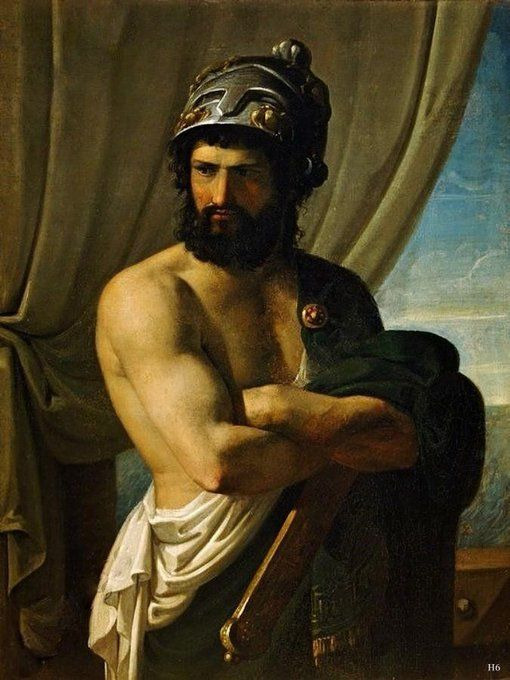
Odysseus (Roman Ulysses) was a mythical king of Ithaca who fought in the Trojan War. For 10 years Odysseus and the other Greeks stormed the lands of Troy, soaking its soil with blood and filling its air with the wails of mourning widows and mothers. Despite this, the walls of Troy held, its armies holding its own against the Greek horde. Eventually Odysseus came up with a way to crush Troy once and for all.
The Trojan Horse.

This was a giant hollow wooden horse that was presented to the enemy Trojans as a “peace offering”. Thinking that the Greeks had given up, the Trojans took the horse into Troy, where a massive party was held. However, after almost everyone passed out or went to bed…Greek soldiers poured out of the horse, eventually opening the city gates. The night shook with the collective battle cries of thousands of ferocious Greek warriors, who rushed into the city with murder in their eyes. Arrows and javelins crisscrossed in the air as houses were put to the torch and drunken Trojan soldiers were put to the sword. Civilians fared no better as the city came down, as the Sons of Greece howled in victory.

Odysseus was now a hero, a man admired by all the Greeks. He looked forward to going back home to Ithaca, to his wife Penelope and his son Telemachus. Their faces must have been on his mind as his ship sailed away from the Trojan shore, his battles now behind him.
Or so he thought…

On his way home, Odysseus stumbled upon an island that at first seemed just like that of any other in the Mediterranean region. However, after entering a cave filled with food, they soon discovered that the island was inhabited by cyclopes, one eyed giants with more attitude than a Pitbull that’s just been neutered.

One of these, Polyphemus, actually lived in the cave that Odysseus and his men had found. Enraged, Polyphemus kept them prisoner in the cave, eating several of them. Eventually, Odysseus decided to get Polyphemus drunk, where he would be vulnerable. As Polyphemus drank, he asked Odysseus his name. Odysseus lied, saying that his name was “Nobody” or “Noman” (depending on the translation). Once the brute succumbed to the wine, Odysseus and his men rammed a large, freshly made spear into Polyphemus’ eye. Polyphemus roared like a pride of lions, which prompted his oversized brothers to walk towards his cave, asking him what was going on. Remembering the name Odysseus gave him, Polyphemus became to Greek Mythology what Moe the Bartender is to the Simpsons:
“Noman is killing me by fraud;
no man is killing me by force.”

Hearing the term “Noman”, the other Cyclopes concluded that no one was hurting Polyphemus and that he was sick. Realizing that he’d been dumped, Polyphemus removed the stone door and stood at the opening of the cave, feeling around with his hands to make sure that none of the Greeks escaped. However, Odysseus looked at Polyphemus’s sheep, suddenly getting an idea. He and all his men got underneath the sheep, holding onto their fleece for dear life as the beasts crawled under the wrathful cyclops, who didn’t bother to check their undersides. Later, as Polyphemus tore the top of a mountain off and threw both it and a temper tantrum, Odysseus called out to him from his ship, revealing his true name.
Bad move.
You see, Polyphemus wasn’t just some run-of-the-mill fantasy monster; he was the son of Poseidon, wrathful god of the sea.
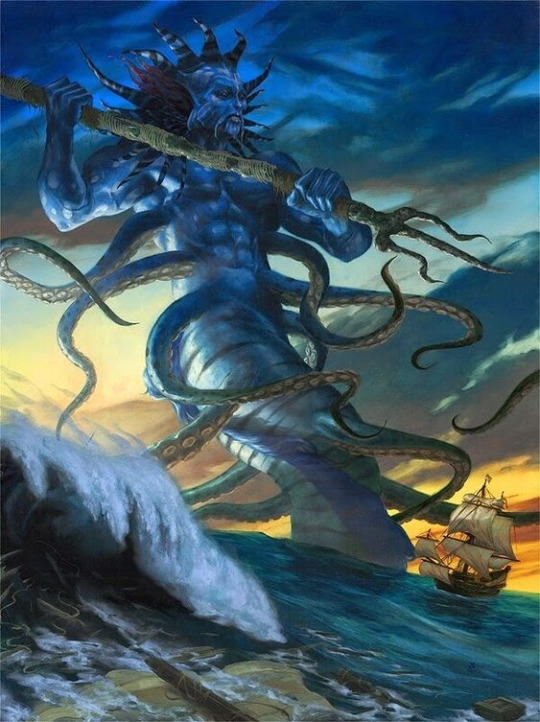
To avenge his son, Poseidon condemns Odysseus to wander the sea for ten years. During this time Odysseus has many adventures, encountering anything from ghosts and ogres to goddesses and sea monsters. Eventually, he reaches home, where he finds that dangerous men are putting pressure on his wife Penelope to marry one among them. Together with Telemachus, Odysseus slays them, regaining control of his homeland.
The story of Odysseus is one of the greatest tales of Greek Mythology. Odysseus is a thinking hero, one who uses his mind instead of brute force to tackle obstacles of every conceivable kind. He is no son of a god, but a man of mortal parents who braves both beasts and the divine in order to make his way home. But did his story inspire the creation of new gods? Indeed, was he the basis for Jesus Christ? Was Jesus a mythical figure based on this Greek hero?
Let’s see why this isn’t the case.
1. Incarnate God?
No, Odysseus was all mortal.
2. Son of God?
No, both his parents were mortal.
3. Trinity?
No, once again, he was a mortal man. He was not a god, let alone a person within a trinity.
4. Born of a virgin?
No, his parents had sex.

5. Star proclaimed his birth?
No.
6. Visited by wise men after his birth?
No.
7. Someone sought his death after he was born?
No.
8. Taught in a temple as a boy?
No.
9. Baptized?
No.
10. Tempted by the Devil?
No.
11. King?
Yes, Odysseus was a king. Jesus is too, though not of any earthly kingdom (John 18:36-37). He is the true King of the Jews (Isaiah 9:6-7, Matthew 2:2, Luke 23:3, John 1:49-50, 18:36-37) as well as the divine king (Revelation 19:16).
BTW: so, what? Are we going to say that Odysseus was based on Gilgamesh, Minos, Saul or Solomon, because they, like Odysseus, were also kings?
12. Carpenter?
Yes, just like Jesus…and countless other people throughout history, big deal. There were also a lot of kings. Once again… are we going to say that Odysseus was based on Gilgamesh, Minos, Saul or Solomon, because they, like Odysseus, were also kings?
13. Preacher?
No.
14. Prophet?
No.
15. Miracle worker?
No. Odysseus did eat a plant called Moly that made him immune to the Witch Goddess Circe’s powers, but this a far cry from performing a miracle. Was the Dread Pirate Roberts a miracle worker when he swallowed a magic pill that brought him back from being “mostly dead” in the movie “Princess Bride”?

Was Alice of “Alice in Wonderland” a miracle worker when she ate food that made her grow and drank a potion that made her shrink?

Ingesting a magic pill or magic food and potions doesn’t make them miracle workers, anymore than ingesting a real life pill makes a mechanic a doctor.

16. Multiplied bread and fish?
No, see above.
17. Walked on water?
No, see point 15 again.
18. Raised the dead?
No. Once again, point 15.
19. Healed the sick?
No. Once again, Point 15!
20. Cast out demons?
NO! POINT 15!!!!
21: Had supernatural enemies?
Oh wow! Supernatural enemies? That’s very hard to find in stories about heroes from both religious texts and myths!
I mean, that’s got to be so RARE!
Who would have thought?
Okay reader: time to do an eyeroll. Just get it out of your system, it helps when being exposed to Jesus Mythicist stupidity.

22. Had disciples?
No, he had soldiers, and they numbered far more than twelve (he had an army).
23. His “followers” acted Foolishly at times?
Yes, but once again, remember that Odysseus had soldiers, while Jesus had Disciples (meaning “students” in Greek).
24. Debated religious leaders of his day?
No.
25. Betrayed?
Odysseus was no stranger when it came to betrayal.
Once, when his last ship (the others being destroyed) reached the Island of the Sun God Helios, he made his crew swear not to kill any of Helios’ sacred cattle on the island. He had been warned by the ghost of the prophet Tiresias that if they killed them, then a catastrophe would occur. His men swore, but while Odysseus slept, Eurylochus, one of his soldiers, convinced the others to kill the cattle. Facing starvation, the men broke their vow. This ticked off Helios, which in turn ticked off Zeus, and…A storm at sea killed the rest of Odysseus’ men.
Odysseus was also betrayed by the suitors, men who wanted to marry Penelope. Their acts of rape and inhospitality was a stain on his honor. They had also tried to kill his son, and had even led some of his servant women to commit crimes against the state. Later, when he revealed himself to the suitors, Melanthius, one of his own goatherds, supplied them with weapons.
Jesus likewise was betrayed by Judas over thirty pieces of silver. A similarity…but not enough for Jesus Mythicists to make their case.
Indeed, how many people in the world have been betrayed?
26. Betrayer died soon after?
Eurylochus and the rest of Odysseus’ men died soon after killing Helios’ cattle. Likewise, Melanthius died soon after providing the suitors with weapons. However, both the suitors and the servant women carried out their betrayal for years before being stopped by Odysseus. Indeed, Melanthius had been allied with them for a while before the day when he gave them weapons to fight Ulysses.
27. Crucified?
No, Odysseus died of old age. In one version, he died defending his shepherds from Telegonus, his son by Circe. Telegonus afterwards learned that the man he killed was his father, who he had been searching for. In other versions he was exiled, in one dying of old age, in another his fate unknown. In the Odyssey, it indicates that his life will have a happy, fairy tale-style ending.
There is not one version where he is crucified.
Some Jesus Mythicists might state “but the story where he goes to Italy, one where his final fate is not known…he could have been crucified! It’s a possibility!!!”
Actually, no. You see, for one, such an argument would be an Appeal to Possibility, a logical fallacy where one tries to state that something is true because it is possible. Might as well say that he was mauled by a bear, because it’s possible, or hunted down by the Sirens because it is possible, or struck by Zeus’ thunderbolts because it’s possible, or clubbed to death by a prostitute in retaliation for him not paying her adequately enough because hey, its possible.
All of these possibilities hold the same amount of weight.
None.
Two, it’s also an Appeal to Ignorance fallacy, accepting something as true based on lack of evidence that shows otherwise. Imagine if someone not only claimed that a giant clone of Zooey Deschanel is in a secret underground government lab, but that, since this claim is not disproven, therefore it is true!

And three, it’s actually NOT possible, because the story of Odysseus existed before the invention of crucifixion. Crucifixion was invented in Persia in the 6th century BC. Homer’s Odyssey, on the other hand, was written about the 8th-7th century BC. True, Plutarch, who mentions the version of Odysseus going to exile in Italy, wrote in the second century, but let’s remember…he wrote in the second century. When was the New Testament written?
First century AD.
Now, you may be wondering where Jesus Mythicists got the idea that Odysseus was crucified.
Prepare to shake your head.
Odysseus once had to sail pass the isle of Anthemoessa, home of the Sirens. Sirens were singing sea nymphs who had the heads of women and the bodies of birds.
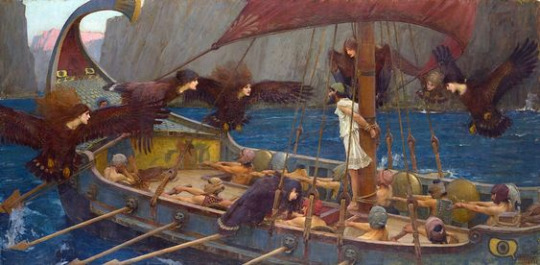
If you can imagine Katy Perry and a young Dolly Parton with the bodies of oversized eagles or hawks, you get an idea of what they would have been like.


However, their singing voices were even better than those of Parton or Perry. Indeed, their voices were enchanted, luring men toward Anthemoessa’s rocky shore. This led to a lot of ships sinking and a lot of men drowning, their bodies consumed by the Sirens. Wanting to avoid the same fate, Odysseus has his men stuff their ears with wax, which rendered them immune to the Siren’s allure. However, Odysseus had his men tie him to his ships mast, so that he could safely hear the sirens. Their song was so beautiful, so hypnotizing, that his men had to put stronger straps on him. After sailing to a safe distance, Odysseus was freed from the mast.
The following is an ancient Greek vase that depicts this mythological story:
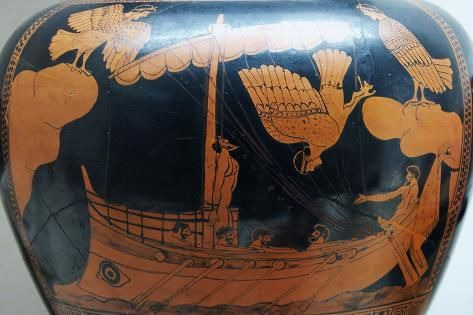
Here is a closer look:
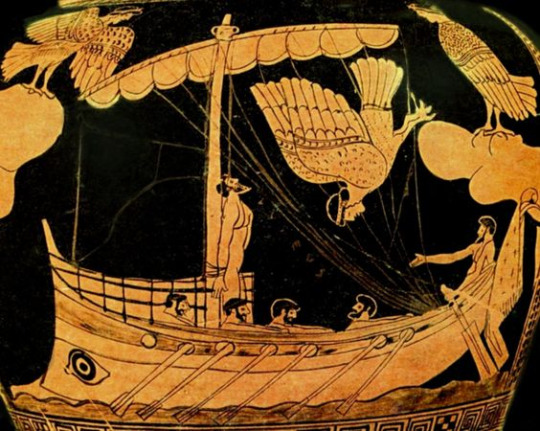
This is their proof that Odysseus was crucified.
Um…somebody forgot to tell them that being tied to a ship’s mas doesn’t = crucifixion.

Indeed, he wasn’t even being executed; he was simply being strapped down so that he could safely listen to the siren’s song.
Now, some Jesus Mythicists will try to point out similarities between these two events; Odysseus is strapped to a ship’s mast, which is both made of wood like a cross and with a similar shape to that of a cross (especially so with the sails rolled up), all the while standing straight up. Likewise, Jesus is nailed to a wooden cross, which is lifted straight up, Jesus body being vertical as well. Both are in anguish during this (Jesus due to pain, Odysseus due to not being able to go to the Sirens).
Parallel, right?
Wrong.

Crucifixion not only was a death penalty in Jesus’ time, but, as previously stated, it was being used to execute criminals since the 6th century BC. If the Gospel writers were making the story of Christ’s death up, why would they draw inspiration for the crucifixion from Odysseus being tied to a ship’s mast…instead of crucifixion itself, which was a common form of execution at the time? Remember, Odysseus wasn’t crucified; he was simply tied to a ship’s mast.
He…didn’t…die.
Now, some will counter this by saying that some ancient Christians made comparisons between Odysseus’ being tied to a mast and Jesus being crucified. However, this doesn’t mean that Christians were inspired by Odysseus’ tale to invent the crucifixion of Christ, any more than historians making comparisons between Alexander the Great and Achilles (both of whom share many parallels with each other) means that historians were inspired by Achilles to invent Alexander the Great. Andre the Giant, the late professional wrestler, bore many striking similarities with the mythic Hercules. If I note these similarities(which I did in another article, see the sources section below)...does it mean that I think that Andre the Giant didn’t therefore exist? No, it just means that I noted their similarities. I likewise wrote an article on the fem chatbot Tay, noting its striking similarities with Frankenstein’s monster (as well as with many other similar creatures in cinema, folklore and myth. See sources section below). Does that mean that I therefore think that Tay was a fictional character, not a real computer program? Anybody reading my article on Tay would know that wasn’t the case. Heck, people have compared the sinking of the Mignonette to “The Narrative of Arthur Gordon Pym of Nantucket” by Edgar Allan Poe, due to both also sharing many parallels (Poe’s novel predates it by decades). Does this mean that someone was inspired by Poe’s novel to invent the story of the Mignonette? Likewise, many have compared the Titanic disaster to the novella “Futility/Wreck of the Titan” by Morgan Robertson, both of which also share many parallels (Robertson’s book written 14 years before the Titanic was put to sea). Does this mean that someone was inspired by Robertson’s book to invent a fictitious Titanic?
Then why would Christians making a comparison between Jesus’ crucifixion and Odysseus being tied to a mast be evidence that Christians were inspired by the latter to come up with the former?

Keep in mind; the three examples I’ve cited above have FAR, FAR, FAR, FAR, FAR, FAR more parallels between them than Jesus’ crucifixion and Odysseus’ being tied to a mast have. Indeed, the similarities between Christ’s crucifixion and Odysseus being tied to a mast are far outweighed by the fact that one was a crucifixion and the other is not, one is an execution, the other an attempt to avoid death yet still hear the Siren’s song. One’s nailed to a cross to die for our sins, another is tied to a mast in order to both learn and survive a mystery.
Yep, they’re about as similar as Reese Witherspoon and Alice Cooper.


Folks, there is no crucifixion here, let alone something that inspired it.
28. Went to the Underworld?
Yes, Odysseus did, though he didn’t die in order to go there. He went there while still alive so that he could speak with Tiresias. After Jesus died, he went to the “heart of the earth” (meaning Hades (Old Testament “Sheol”), the abode of the dead) for three days (Matthew 12:40, Acts 2:27-31). One could say that they both went to Hades, due to the fact that the Hebrews borrowed the Greek name for the Underworld, replacing Sheol with it, but the differences in the story are far more startling than the similarities. Odysseus went to the Underworld while alive and left, while Jesus died, went there, and then resurrected.
29. Resurrected?
No, see points 27 and 28
30. Ascended into Heaven?
No.
31. Second coming?
Odysseus did return to Ithaca, just as Jesus will return one day to earth. However, Odysseus returned, while Jesus will return. There is not an enormous amount of theological significance to Odysseus returning to Ithaca as there is with Jesus returning to Earth. Its more akin to Robin Hood’s return from the Crusades than Jesus’ Second Coming.

33. Went in supernatural disguise?
After Odysseus returned to Ithaca, Athena disguised him as an old man, which allowed him to go unrecognized by the suitors. This was done to save his life; the suitors would have killed Odysseus if they saw him returning home. His true identity was later revealed when, out of all the suitors, only he was able to bend his own bow (one that he left in Ithaca before sailing off to the Trojan War) and firing an arrow through the heads of twelve axe handles. After this, both Odysseus and his son slew the suitors. Likewise, after Jesus resurrected, he encountered Mary Magdalene, who didn’t recognize him until he called her name (John 20:11-18). Later, he also encountered two other followers of his on the Road to Emmaus, neither of which recognized him at first, courtesy of divine power (Luke 24:13-16). After striking up a conversation with them, Jesus sat with them at dinner. As he blessed the bread, broke it and gave it to both, the men suddenly recognized who he was...only for Jesus to vanish (Luke 24:17-31). Just as Odysseus showed signs of who he was while disguised (i.e. stringing the bow and firing it through the twelve axes), Jesus showed his unparalled knowledge of the scriptures with the men on the road to Emmaus, who felt their hearts burn as he spoke (Luke 24:25-32).
Admittedly, there is a striking similarity between Odysseus and Jesus in this regard.
However...so what?
As I mentioned in point 27, there have been many occasions in history where a historical figure or event bore numerous striking parallels with myths or fictional tales. This isn’t evidence that the historicity of those individuals or events should be called into question. Whose going to deny the historical existence of the Titanic, Mignonette, Andre the Giant, Tay or Alexander the Great because they were prefigured by mythic or fictional accounts that bore striking similarities with them?
Indeed, with all the mythic characters and stories, with all the historical figures and events that have occurred in the world, one would expect that eventually, some historical figure or event would arise that would bear parallels with mythical figures and tales, or vice versa.
This isn’t evidence of borrowing or inspiration.
Its evidence of math.
And, as we’ve already seen in most of the other points, Odysseus and Jesus really don’t parallel each other that well.
Indeed, they mostly don’t parallel at all.
34. Reign in a future age?
No, he reigned on earth in the remote past.
The connection between Jesus and Odysseus is spurious, and yet people still promote the idea. Indeed, Dennis R. Macdonald, a scholar who wrote “The Homeric Epics and the Gospel of Mark”, not only claims in his book that much of Jesus’ story is derived from that of Odysseus, but also from other elements found in Homer’s works. Indeed, he even claims that the story of Jesus walking on water was derived from Homeric stories of Hermes…flying over water.
I’m not making this up. He actually wrote this.

He also wrote that the story of Jesus death was partially inspired by the death of Hector in the Iliad (who was slain by Achilles in battle, not crucified), and that John the Baptist’s death was inspired by myth of King Agamemnon’s death! Now, let’s look at that last one, shall we? Agamemnon was killed by his wife Queen Clytemnestra and her lover Aegisthus (some accounts its Aegisthus and twenty other men). In some ancient sources, he was killed while taking a bath. In one version, Clytemnestra threw a net on him and then twisted it, before Aegisthus swung his sword or axe (in the version where her lover has a sword, Clytemnestra strikes Agamemnon with the axe afterwards). In another version of the death-while-bathing myth, Agamemnon is wearing a shirt with sleeves that are sown up, which likewise renders him helpless against the axe). Other sources state that he was killed while sitting at a table. The only similarities between his death and that of John the Baptist is that they were killed by royalty (Aegisthus ruled Mycenae) and they were both beheaded. An interesting parallel…until you realize that beheading was a form of punishment in ancient Greece and Rome and that kings could and did command that some people be beheaded. I could also mention that Herod Antipas, who had John the Baptist beheaded, was not actually a king, bur a Tetrarch, a ruler over a quarter of a province or region (the Romans also used it to refer to someone who ruled over any portion of the empire). Though the author of the Gospel of Mark used the term “king” for Herod Antipas, he was either using the word loosely, or being sarcastic. Indeed, his wife Herodias planned to make him a real king. When Herod Antipas appealed for the title of king, he was rewarded by the Romans with exile to Gaul. Thus, he wasn’t royalty.
And yet…Agamemnon’s death was supposed to be the basis for that of John the Baptist…
Just as Odysseus was supposed to be the basis for Jesus…
Can you say “WRONG”?

Folks, Jesus wasn’t based or even inspired by Odysseus, let alone Homer’s Odyssey or Iliad. Jesus is a historical figure, not a mythical figure. Jesus is real, not a figment of Homeric tales.
Jesus is the real deal.

Sources:
“The Odyssey” by Homer (Translated by Samuel Butler), 87-96, 110-111, 122-30, 177-78, 226-35
https://www.theoi.com/Text/HomerOdyssey9.html
https://www.theoi.com/Text/HomerOdyssey22.html
“The Ultimate Encyclopedia of Mythology” by Arthur Cotterell and Rachel Storm, 17, 19-20, 34, 60, 66-67, 74, 76, 78-79, 88
“The Penguin Dictionary of Classical Mythology” by Pierre Grimal, 19-20, 25-27, 300-06
https://www.blueletterbible.org/faq/don_stewart/don_stewart_1336.cfm
“Homer's Odyssey and the Near East” By Bruce Louden, 277
https://www.google.com/books/edition/Homer_s_Odyssey_and_the_Near_East/AKDfiWrXAx8C?hl=en&gbpv=1&dq=Suitors%2BBetrayed%2BOdysseus&pg=PA277&printsec=frontcover
“Women, Crime and Punishment in Ancient Law and Society Volume 2: Ancient Greece” By Elisabeth Meier Tetlow, 25
https://www.google.com/books/edition/Women_Crime_and_Punishment_in_Ancient_La/3fnsWhZkq74C?hl=en&gbpv=1&dq=Suitors%2BBetrayed%2BOdysseus&pg=PA25&printsec=frontcover
https://www.historic-uk.com/HistoryUK/HistoryofEngland/Robin-Hood/
https://www.theoi.com/Pontios/Seirenes.html
“Jesus, Paul, and Power Rhetoric, Ritual, and Metaphor in Ancient Mediterranean Christianity” By Rick F. Talbott and S. Scott Bartchy, 143
https://www.google.com/books/edition/Jesus_Paul_and_Power/yxJTAwAAQBAJ?hl=en&gbpv=1&dq=Odysseus%2BMast%2BJesus%2Bcrucified&pg=PA143&printsec=frontcover
https://sirtravisjacksonoftexas.tumblr.com/post/628287347439665153/alexander-the-great-and-achilles-examining-the
https://sirtravisjacksonoftexas.tumblr.com/post/628113211750776832/do-supposed-parallels-between-the-gospels-and
https://www.britannica.com/topic/crucifixion-capital-punishment
https://www.britannica.com/topic/Odyssey-epic-by-Homer
https://www.ancient.eu/odysseus/
https://bmcr.brynmawr.edu/2000/2000.09.16/
https://www.logicallyfallacious.com/logicalfallacies/Argument-from-Ignorance
https://www.logicallyfallacious.com/logicalfallacies/Appeal-to-Possibility
“Encyclopedia of Women in the Ancient World” By Joyce E. Salisbury, 66
https://www.google.com/books/edition/Encyclopedia_of_Women_in_the_Ancient_Wor/HF0m3spOebcC?hl=en&gbpv=1&dq=Agamemnon%2Bbeheaded&pg=PA66&printsec=frontcover
https://www.newworldencyclopedia.org/entry/Beheading
https://www.britannica.com/topic/beheading
https://www.google.com/books/edition/Mortal_Republic/P2RPDwAAQBAJ?hl=en&gbpv=1&dq=Pompey+beheaded&pg=PT206&printsec=frontcover
“The IVP Bible Background Commentary: New Testament” by Craig S. Keener, 85, 150-51.
https://www.livius.org/articles/person/herod-antipas/
“Bible Understanding Made Easy: Volume 3: Mark’s Gospel” By Anthony L. Norwood, 23
https://books.google.com/books?id=g2DkENMbNnoC&newbks=0&printsec=frontcover&pg=PA23&dq=tetrarch+roman+empire&hl=en&source=newbks_fb#v=onepage&q=tetrarch%20roman%20empire&f=false
https://www.britannica.com/topic/tetrarch-ancient-Greek-official
“Clash of the Gods” documentary series: “Odysseus: Curse of the Sea” and “Odysseus: Warrior’s Revenge” episodes
“The Portable Seminary: A Master’s Level Overview In One Volume”” by David Horton (General Editor), 281
“Quaestiones Graecae” (The Greek Questions) by Plutarch, section 14
http://www.perseus.tufts.edu/hopper/text?doc=Perseus%3Atext%3A2008.01.0215%3Asection%3D14
http://www.perseus.tufts.edu/hopper/text?doc=Perseus%3Atext%3A2008.01.0215
https://sirtravisjacksonoftexas.tumblr.com/post/615781564580773888/was-jesus-a-fictional-character-based-on-pagan
https://sirtravisjacksonoftexas.tumblr.com/post/624904287995265024/do-so-called-similarities-between-jesus-and
“The Princess Bride” film
“Alice in Wonderland” Disney cartoon.
0 notes
Text
Revisiting The Two Princesses of Bamarre
I have a problem with romance in YA novels. I’m the first to admit it--almost the moment the “dreamy guy” comes into the picture, I consider a book substantially worse than I had the moment before. While there’s nothing wrong with it, I just personally don’t enjoy the style of romance in most YA novels, wherein only by exchanging glances, or worse, by exchanging only your darkest secret with someone, they become your soulmate. One author, however, excels at writing complex romances where personality and the factors of daily life do affect the relationship between two characters in love in a way that makes them more realistic and less of a turnoff for me personally. Gail Carson Levine, revered author of Ella Enchanted, wrote two books in the Bamarre universe, but Two Princesses of Bamarre is by far my favorite. It tackles loss, love, and realistic romance in a mature way while still sticking to the target age level. The female hero of the story is driven to her epic quest, and driven through it, by those forces, to save her sister and her kingdom.
I first read this book when it came out in 2001, and I’ll admit I chose it for its cover art, as I often did when I was 10. I didn’t realize at the time that the author was the same as that of Ella Enchanted, a book that I loved and a movie that I hated, but looking back, it’s very similar. In both stories, the hero faces a gauntlet of real dangers and practical problems without the ‘plot armor’ that you sometimes see in these stories, where it’s unlikely there will be blood or death because of the character’s purity of heart or immense luck. However this story, more so than that retelling of Cinderella by Levine, follows the conventions of an epic journey, like those of Odysseus and Beowulf. The story is actually strung together with verses from the fictional epic poem “Drualt,” about a mythical hero represented in the story of the kingdom's founding. In a magical world constructed with a history and mythology which directly impact the fate of both princesses, Princess Addie makes herself and her mission a concrete part of that history and mythology in very unexpected ways.
Bamarre is a country torn apart by a plague called the “Grey Death,” which inevitably kills its victims over the course of three distinct stages--weakness, sleep, and fever (which proves fatal). The weakness can last any amount of time, during which the host can fight off the coming sleep as long as they can, but the sleep lasts nine days exactly, and the fever three. The country is also plagued by a number of mythical monsters--gryphons, dragons, specters, ogres, dwarves, and fairies--however it is also partially populated by sorcerers and elves (the fairies have not been seen for a long time, and people have come to believe that they may not have existed). When Princess Meryl, the stronger, braver, and fairer of the two titular princesses, falls ill with the Grey Death, Princess Addie recalls a prophecy that the Grey Death will end when “cowards find courage, and rain falls over all of Bamarre.” Cowardly though she is, Addie sets herself to the task of saving her sister’s life before time runs out.
Every time I read this book, I am frightened. It does not matter that I know how it ends. Addie and Meryl, and their friend the apprentice sorcerer Rhys, each face their individual struggles so bravely with expected futility, and it’s impossible not to empathize. When the story begins, we’re given a picture of Meryl and Addie’s childhood, playing out scenarios where Meryl quests to find the cure for Addie, the maiden stricken with the Grey Death. Addie is adamant that the illness can be beaten just by struggling against the lethargy that precedes the sleep phase, and promises to Meryl that she will never die of the Grey Death, in exchange for a promise from Meryl that she will not begin to hunt the cure until Addie herself is happily married. Addie is overcome with fear that Meryl will die on her future adventures, as Meryl is Addie’s ‘protector’--saving her from everything from shadows to spiders to social situations. But when Addie’s handmaid falls ill with the Grey Death, it stops seeming like a game to them, and Meryl’s desire to leave her sister and go to seek a remedy grows.
This is the moment where the ‘dream guy’ enters the picture, shaping a pillow from the clouds for Addie’s dying maid and complementing the embroidered works Addie has up around the castle. Rhys is a sorcerer, apprenticed to the royal sorcerer in Bamarre, and he, being a different species from her, is both fascinated by and alien to Addie, at first. Sorcerers in Bamarre are born when lightning strikes marble. They’re born fully grown, able to speak and fly, and they never fall ill. They don’t have to eat or drink, but can be killed in battle or by mishap. Otherwise, they live until they are 500, and die when the flame in their chest goes out. They are all tall, with dark wavy hair and white eyelashes, and usually never marry. As annoyingly typical as I find this immortal, youthful, handsome, tall, romantic interest, Rhys manages to divest himself from the trope by having a number of responsibilities and interests which he prioritizes equally, if not more heavily, than his romantic interest in the younger princess. Eventually, when his work brings him to the castle, he gives Meryl the gift of a sword, and Addie the gift of fabric and a needle. In return, Addie gives Rhys a work of embroidery, and Meryl offers to re-enact scenes from the epic “Drualt.” Throughout her performance, Rhys and Addie watch Meryl falter, grow tired, and eventually collapse. Despite her protestations, it’s clear that Meryl has fallen ill, and Rhys tries to tell Addie this, but Addie runs from him.
The King of Bamarre, father to both princesses, sets out to ask the Elf Queen Seema for a cure, despite having no evidence that she has one, and around the same time, Rhys leaves for a conference of sorcerer's apprentices that is, for his species, mandatory. However, after a week, the King meets with Queen Seema and is told there’s no cure. He comes home, and gives up on finding a remedy, opting instead just to say goodbye to his daughter. Rhys warns Addie that Meryl has, at most, 19 days left to live, and Addie comes to the realization that if it were her who’d fallen ill, Meryl would already be questing for a cure. Before she leaves, and before Rhys takes off to the sorcerers’ citadel, he gives her a set of equipment to help on her journey. In the bundle he gives her are a cloak which will hide you completely if in shadow, a tablecloth which when given certain commands produces unlimited food, and a set of maps of the kingdom, and beyond. Meryl gives Addie her sword, named “Blood-biter” after the sword from “Drualt”; their elf-doctor Milton gives Addie “moily herb” which can soothe pain and help with illness; and their maid Bella gives Addie some common clothes, a backpack, a spyglass, and seven-league boots.
Pause. I have been obsessed with seven-league boots since the day I read this book. When Google Earth became a thing, I’d click around and pretend I was Princess Addie, journeying seven leagues with each step, leaving landscapes streaking behind. They come more heavily into play throughout the story, but I have always loved the concept that they present, and the danger. Wearing the boots, you can accidentally slam into a building, or trip and travel seven leagues that you didn’t mean to. Addie’s caution and creativity in their use, combined with the spyglass and maps, for me represent the perfect use of a magical tool in fantasy. It is not a deus ex machina, it cannot solve all problems and in many ways creates new types of problems, but can be incredibly advantageous if used by the right hero, in the right way, for the right reasons.
To return to the story - Addie, predictably, stumbles with her first step in the boots, and travels backwards 14 accidental leagues, slamming immediately into her first opponent: a large ogre in a party of four large ogres. He grips Addie and readies himself to attack her, when she uses the seven-league boots to smash him against a castle wall and escapes. All of this has the effect of introducing a few elements to her journey very quickly--enemies, pain, and quick thinking. She goes from hapless princess to adventurer in these moments, and in my opinion, her agony at dragging the ogre another 14 leagues and ability to only barely save herself distinguish this YA novel from others. Rather than an easy escape or an immediate ogre-concussion, Addie has to actually fight, aim, and plan while travelling faster than she ever imagined.
Rhys takes breaks from the citadel to visit Princess Addie on her journey, finding her through what we can only assume are magical methods. When Addie reaches the forest of the specters (precognizant gaslighting tricksters, who appear as loved ones or innocents to lure travelers to their death) Rhys visits her and tells her there is a cure hidden in the forest. Addie only realizes the trick when the real Rhys appears. Demanding a prophecy from the specter, Addie is told that dragons and fairies know the cure, and that dragons are easier to find. But unfortunately, a dragon finds Addie first. Vollys, a dragon who has been the scourge of Bamarre and whom Princess Meryl had hoped to one day slay. Vollys takes Addie prisoner and demands from her entertainment, which Addie provides in the form of her embroidery. Vollys has a system in which she gives gifts to her prisoners when pleased, and takes them away when displeased. The gifts represent how much longer the prisoner has to live. Addie exchanges weeks of her life for the story of the cure to the Grey Death while she watches Meryl’s condition worsen with the spyglass, and waits for her chance to escape.
Addie’s imprisonment with Vollys represents, to me, the perfect marriage of fairytale tropes and the uniqueness of this story. Princess Addie was the quieter, more reasoned sister, whereas Meryl would have been a warrior, and would have been roasted after quickly boring Vollys with fruitless attacks and little conversation. So while there’s a young princess being kept prisoner by a fire-breathing dragon, the hero who rescues her is not a knight in shining armor but herself, a shy girl who likes to sew and is afraid of spiders. And that’s the hero that is needed. A knight would have become charcoal in this fight, but Princess Addie is the right opponent for this enemy. Addie’s escape with the knowledge of the far-off cure, a magical fountain with water that must be drunk at the source, comes at the end of Meryl’s third day of fever, when she has until dawn to live. The battle to reach the falls is as good as any epic battle I’ve read in my life.
I couldn’t spoil the end of this story if I tried. Too many elements of the story come together to break and heal your heart simultaneously, but I will say that it does not end entirely happily, and that Princess Meryl keeps her promise to Addie to postpone her own adventures until after her sister is happily married. But while the kingdom is saved, nothing is the way you would expect it to be. I will admit to being furious with this ending as a young reader, having up to this point pretty much only read books where everything works out for the heroes at the end. As an adult I can see the genius in this ending, while still being crushed by it. The cowardly and fearful of Bamarre rise up to save their princess, and they save the kingdom instead. I remember being ten or so and crying, freaking out, and running to find my little brother when I finished this book, just to make sure he was ok. In a book that mainly features battles of strength and wit against physical monsters--ogres, gryphons, dragons--the real pain comes from something that exists in the real world; loss. And sometimes, like in the real world, it’s unavoidable, and the love which nourished you is the same love that causes you to hurt when it’s gone. But in a book with incredibly strong mythos to begin with, it’s immensely satisfying to see the characters join the fabric of history and myth surrounding their world.
1 note
·
View note